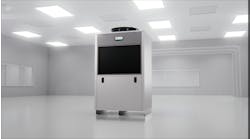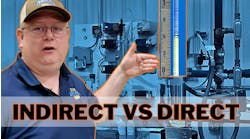Latest from Hydronics
Indirect vs. Direct Water Level Indicators Explained
Sponsored
In a previous article I promised that we would venture into the word of light commercial pump sizing using variable speed pumps (July, p. 36). How many times have we been called upon to work on a commercial system, typically a multifamily application, and stood there looking at an array of gigantic pumps and wondered to ourselves whether this was the right pump for the job or not? Back in the day, before the use of pressureactivated bypasses, it was, and still is quite common to have zone valvecontrolled heat emitters connected to pumps whose operation is based on outside air temperatures.
There was little to no correlation between real-time energy demand loads and the need for heat and circulation. The components of the “system” were sized based on design conditions that rarely occur for more than 2% of the time here in the lower contiguous United States. Reading this backwards, the “system” is most definitely grossly oversized for 98% of the time it is in operation. I, too, am guilty of doing this, because it has historically been the least expensive, most common way to design and install light commercial hydronic heating systems.
Think of this “system” as a large, one-cylinder engine. Not very efficient, extremely dependable, but it does get the job done in a hurry. It just keeps turning on and off a lot. You have to modulate the output by rapidly turning the ignition switch on and off to maintain a lower speed, if you will. Over the years, the design community has gotten smarter by using multiple, smaller heat sources in an effort to reduce off-cycle standby losses and increase overall efficiency, and this has been shown to be an effective way to reduce energy consumption. Now, instead of large single cylindered engines, we have the equivalent of a 2-, 4-, 6- or 8-cylinder engine. We’ve even added the equivalent of a floating fuel throttle through the advent of air/fuel modulation. With each boiler having a five-to-one turn-down ratio, as we add more boilers to the mix, we end up with even higher turn-down ratios. With two boilers, we get a 10- to-one turn-down ratio, with three we get 20-to-one, and with four, a 40-toone turn-down ratio and so on and so forth. A much better use of the thermal horsepower.
Unfortunately, we haven’t done much to optimize the prime mover of the fluids within the system, the circulators. Our pumps still think our buildings are at design condition every time they are called upon to operate. Without the use of a pressure-activated bypass, this can and quite often does result in the system zone valves acting in the role of pressure-activated bypasses. The only problem with this scenario is that we are then dumping unwanted, unneeded, extremely expensive heat into the conditioned spaces, significantly overheating the spaces and wasting thermal and electrical energy.
It has been my personal experience that the majority of complaints associated with the operation of comfort systems is discomfort due to overheating. Generally speaking, if people are complaining because they are cold, there is a failed component in the system. If they are uncomfortably warm, it is due to design deficiencies.
So, how does one address this problem? Previously, the contractor could install two pumps of 50% capacity and stage their operation based on ambient temperature. This is a lot better than the one-size-fits-all method, but it still is overkill during certain times of the heating season. Alternatively, the contractor could install a pressure-activated bypass and help eliminate the bypass conditions occurring through the zone valves at the point of use.
Thinking about how to modulate pump capacity, ideally speaking, the circulator would have the ability to “see” real time energy loads and modulate its output to match system demand. This would eliminate the continuous zone valve bypass scenario we just discussed; it would lessen the chances of excess velocity through the few open zones calling for heat during the shoulder seasons, and the associated hydraulic erosion associated with that operation; and it would virtually eliminate thousands of dollars of wasted electricity associated with the one-size-fits-all parasitic costs of operating the pump. I should note that this “intelligence” has been available for quite some time from manufacturers of variable frequency drives, such as Siemens, Honeywell and Danfoss, but its application, however, was limited to threephase pump motors in the range of 1½-HP and larger. That’s not what the smaller, light commercial, multifamily market really needed.
Enter German pump manufacturer Wilo. They recently introduced a line of 220V, single-phase, UL-approved wet rotor circulators in the North American market with the ability to control their ECM motors on a variable-speed basis, thereby matching the circulator’s output to real-time demand. This results in a significant reduction in electrical energy used, eliminating zone valve bypass and the associated waste of thermal energy on the distribution side of the system, and the unnecessary excess wear and tear associated with bypass and excess pump capacity at less than design conditions.
Tune in next month as we continue our journey into the correct sizing of the state-of-the-art circulators in retrofit applications. Until then, Happy Flat Pump Curve Hydronicing.
Mark Eatherton is a Denver-based hydronics contractor. He can be reached via e-mail at [email protected] or by phone at 303/778-7772.
Mark Eatherton
Mark Eatherton material on this website is protected by Copyright 2017. Any reuse of this material (print or electronic) must first have the expressed written permission of Mark Eatherton and CONTRACTOR Magazine.

